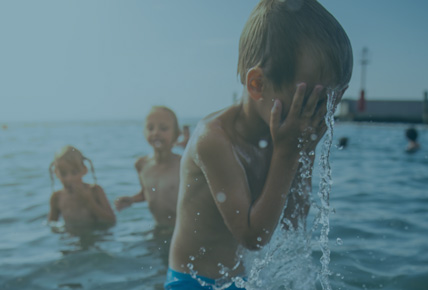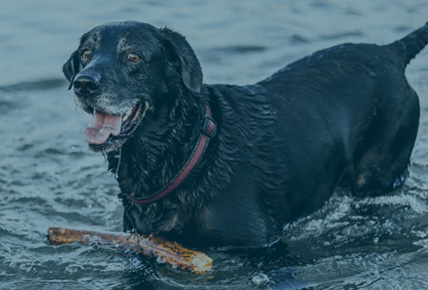We monitor for two health concerns in popular Utah lakes, reservoirs, and rivers.
Related Links
Harmful Algal Blooms (HABs) can produce dangerous toxins that pose serious health risks to humans, pets, and livestock. Learn more below.
Waterborne pathogens (E. coli) can make humans sick. Learn more below.
NOTE: Recreational monitoring has ended for the season. Updates will resume in June or July 2026.
Monitoring
Locations
Health
Watch
Warning
Advisory
Danger
Advisory
Note: This map provides current data on harmful algal blooms AND/OR waterborne pathogens. We do not monitor all the sites on the map for both.
What is an Advisory?
Local health departments issue advisories when waterborne pathogens (E. coli) or harmful algal blooms (HABs) at the water body are dangerous for human and animal health.
There are three different levels: Health Watch, Warning Advisory, and Danger Advisory.
If you are visiting a water body under an advisory, be careful and choose only safe activities.
Health Watch
A Health Watch usually means there is evidence that either waterborne pathogens are present or a harmful algal bloom is developing.
During a Health Advisory:
- Do not swim or water ski
- Do not drink the water or get it in your mouth
If the Warning Advisory is due to a HAB:
- Avoid areas of algae scum when boating
- Keep animals away
- Clean fish well and discard guts
Warning Advisory
A Warning Advisory usually means a threshold established by the Utah Department of Health and Human Services has been exceeded by the water body. This is a strong indication that either waterborne pathogens or a harmful algal bloom is present.
During a Warning Advisory:
- Do not swim or water ski
- Do not drink the water or get it in your mouth
If the Warning Advisory is due to a HAB:
- Avoid areas of algae scum when boating
- Keep animals away
- Clean fish well and discard guts
Danger Advisory
A Danger Advisory means a threshold established by the Utah Department of Health and Human Services has been exceeded by the water body for harmful algal blooms. This means the bloom has become very large and/or high levels of dangerous toxins have been measured. Often a water body is temporarily closed as part of the Danger Advisory.
During a Danger Advisory:
- Do not swim or water ski
- Do not drink the water or get it in your mouth
- Do not boat
- Keep animals away
- Use caution when fishing: the effects of these toxins on aquatic life is not well understood
- If you choose to fish, clean fish well and discard guts
Where do these data come from?
Division of Water Quality staff perform routine monitoring of priority lakes, reservoirs, and rivers throughout the state. These water bodies are generally visited once a month May-October and all updates are posted on the site-specific pages linked above. We also share updates from partner organizations including local health departments, National Parks, and Utah Water Watch.
What is a Harmful Algal Bloom (HAB)?
Cyanobacteria, also known as blue-green algae or harmful algae, aren’t actually algae. Rather, they are aquatic bacteria that photosynthesize like a plant.
There are two types of harmful algae that you should know about:
1
Harmful algal blooms (also known as HABs, blue-green algae, and cyanobacteria)
2
Harmful algae mats (also known as benthic mats)
Harmful algal blooms and mats occur when cyanobacteria multiply quickly to form visible colonies of millions of cells. Sometimes the cyanobacteria that form these blooms can produce toxins which cause illness and can damage the human kidney, liver, or neurologic system. Pets and livestock are more likely to drink water and be hurt by these toxins.

Know what to look for:

If you suspect a Harmful Algal Bloom
- Know how to spot a HAB.
- Don’t swim in water that appears to have a bloom.
- Don’t boat, tube, water ski, or jet-ski on scummy water. These activities can cause toxins to become airborne, increasing the likelihood you will inhale them.
- Don’t let children play with scum in the water or near the shore.
- Don’t let pets or livestock swim in or drink from scummy waters.
- Take photos of what you see and call (801) 536-4123 to report a bloom.
- When in doubt, stay out.

Every time you recreate in water
- Check water body conditions at habs.utah.gov.
- Never drink or swallow water when swimming. It may contain bacteria, parasites, viruses, or toxins that could cause illness.
- Shower after coming into contact with recreational water.
- Rinse animals immediately if they swim in recreational water.
- Wash hands with clean water before eating or preparing food.
- Clean fish well and discard guts.
- Boiling or filtering water will not remove toxins. Boiling may actually release more toxins.
- Wash dishes with clean water only.
- When in doubt, stay out.
What are the Health Effects of Harmful Algae?
HABs can cause skin irritation, gastrointestinal illnesses, and in some cases permanent organ damage or death. You can be exposed to the harmful effects of cyanobacteria by:
Getting them on your skin while swimming or wading.
Drinking contaminated water.
Inhaling airborne toxins while boating, jet-skiing or water-skiing.
In the event you or your pet comes into contact with a HAB, rinse off with clean, fresh water as soon as possible. Remove yourself from the source of exposure and contact the Utah Poison Control Center (UPCC) at (800) 222-1222. UPCC physicians, pharmacists, and nurses trained in toxicology can answer your questions and advise you on the need for further medical or veterinary treatment.
People or animals who are exposed to cyanotoxins may experience the following symptoms:
Direct skin contact or inhalation:
- Skin irritation
- Eye irritation
- Nose irritation
- Throat irritation
- Respiratory irritation
Ingestion:
- Abdominal pain
- Headache
- Neurological symptoms
- Vomiting
- Diarrhea
- Kidney or liver damage
Check for these symptoms in your pet after potential exposure:
- Excessive drooling
- Vomiting or diarrhea
- Stumbling or muscle tremors
- Loss of appetite
- Excessive scratching
- Rashes or hives
- Difficulty breathing or weakness
- Seizures or paralysis (in serious cases)

Children & Harmful Algal Blooms
Children may be at greater risk for infection than adults from toxins produced by HABs.
Children are more likely to drink recreational water accidentally or because they are thirsty. Children also weigh less, so a smaller quantity of toxin may trigger even more of an adverse effect than in adults.

Pets & Harmful Algal Blooms
Pets are more sensitive to cyanotoxins than humans.
Animals may consume large quantities of cyanobacteria if they drink the water, and are more likely to become very ill or die. Dogs are particularly susceptible because scums can attach to their coats and be swallowed during self-cleaning. Learn more here.

Toxins from HABs can enter drinking water supplies.

Blooms may occur in waterfowl hunting season.
What causes HARMFUL ALGAL BLOOMS?
Conditions that lead to Harmful Algal Blooms (HABs) are most common in the late summer and early fall. These include:
- High nutrient levels (phosphorus)
- Abundant sunlight
- Warm temperatures
- Stagnant or slow-moving waters
If these conditions are present for several days, cyanobacteria can multiply to form large blooms that can cover an entire lake or collect in smaller areas. Blooms generally die and disappear after one or two weeks.
If conditions remain favorable, overlapping blooms can occur over the course of several months, giving the appearance of one continuous bloom. Algal toxins can linger for days after a bloom has dissipated, and depending on the type of cyanobacteria present, can even increase as toxins are released from dying cells.
How can I help stop Harmful Algal Blooms?
Excess nutrients, particularly phosphorus, in water bodies can trigger algal blooms. Discharges from wastewater treatment plants, runoff from agricultural operations, and stormwater runoff can carry nitrogen and phosphorus into waterways and promote the growth of cyanobacteria.
You can do your part to improve water quality!
Reduce the amount of fertilizer used on your lawn.
Use only phosphorus-free dishwasher detergent.
Use only phosphorus-free fertilizer when possible.
Keep yard debris from washing into storm drains.
Fix leaking septic systems.
Pick up pet waste.
Reducing nutrient loads to waters is the best way to limit the occurrence of harmful algal blooms. Please visit DWQ’s Nutrient Reduction page for more information on Utah’s efforts to reduce nutrient pollution in our waters.
We also rely on community members to help us spot developing HABs. Join the HAB Squad to assist in monitoring a waterbody near you!
What are Waterborne Pathogens (E. coli)?
Waterborne pathogens are bacteria, viruses, and parasites that can make people sick. These waterborne pathogens can cause diarrhea, vomiting, cramps, fever, and rashes. Escherichia coli (or E. coli for short) is used to measure how likely it is that waterborne pathogens are in recreational water. People are at risk for infection when they swallow water with high levels of E. coli or eat food after exposure without washing their hands.

Every time you recreate in water
- Check water body conditions here.
- Don’t swallow water when swimming.
- Shower before and after coming into contact with recreational water.
- Wash hands with clean water before eating or preparing food.
- Don’t swim after heavy rainstorms.
- Don’t swim or play in stormwater detention ponds or irrigation channels.
- Avoid areas of smelly water or obvious waterfowl or wildlife poop.
How can I tell if there are waterborne pathogens?
It is not possible to tell if the water is contaminated by waterborne pathogens just by looking at it. Make sure to check current conditions for the latest monitoring results.
Is E. coli in water dangerous?
The Division of Water Quality and local health departments use the bacteria E. coli as an “indicator organism.” High levels of E. coli indicate fecal (or poop) contamination and a high probability that illness-causing waterborne pathogens are present.
Health impacts
Recreational activities such as swimming, tubing, water skiing, paddle boarding, and water play increase risk of exposure to waterborne pathogens that can make people sick.
Common symptoms of exposure
- Diarrhea
- Vomiting
- Nausea
- Abdominal pain (cramping)
- Fever
- Rash
What causes waterborne pathogens?
Fecal waste, or poop, is responsible for most of the waterborne pathogens found in recreational waters. Fecal waste can enter surface waters from a number of sources, including:
- People who swim when they are sick with diarrhea and/or vomiting
- Waste from dogs, livestock, waterfowl, and wildlife
- Sewage spills or leaky septic tanks
- Stormwater runoff following heavy rainstorms
- Agricultural runoff from fields treated with manure
- Waste discharges from boats
Recreational water illnesses can be caused by bacteria such as shigella and E. coli, viruses such as norovirus, and parasites such as cryptosporidium and giardia. Symptoms may appear immediately, but some may occur one to two weeks after exposure.
Contact the Utah Poison Control Center at 800-222-1222 or a physician if experiencing an illness that may be related to recreating in untreated surface water.
How can I help prevent waterborne pathogens?
Preventing fecal contamination is the best way to limit the occurrence of waterborne pathogens. You can do your part to improve water quality by taking the following steps:
Don’t swim while experiencing diarrhea or within two weeks of having diarrhea.
Shower with soap and clean water before swimming.
Visit the bathroom before going into the water.
Take children for frequent bathroom breaks and diaper changes. Don’t change diapers near the water.
Fix leaking septic systems.
Pick up pet waste and dispose of it properly.
Stormwater detention ponds and irrigation canals
You should never swim in urban or suburban ponds or irrigation canals. These waters accumulate bacteria, chemicals, and fecal material and can cause serious illness.
Some stormwater ponds are monitored and sampled for waterborne pathogens, stocked with fish, and may even include boat ramps. The public should avoid them anyway–they are not designed for recreational use.
HABs and waterborne pathogens pose a threat to Utah’s water-based recreation, culinary water supplies, aquatic ecosystems, and agricultural and residential (secondary) irrigation uses. Multiple agencies manage and protect these uses and users. DEQ has worked with its partners to help response agencies develop health advisory guidance and response plans.
Advisory guidance
The Utah Department of Health and Human Services (DHHS) and DWQ have prepared Recreational Health Advisory Guidance for local health departments.
Drinking water
A number of drinking water sources in Utah are vulnerable to HABs. Learn more and check water conditions with these resources.
Agriculture
The Utah Department of Agriculture and Food (UDAF) has developed a Response Plan to inform, educate, and engage with agricultural producers when water-quality issues arise from HABs.
Other resources
We have compiled a list of additional HABs resources for response agencies, including general information on HABs, EPA guidance documents, important publications, and other useful resources.

Hannah Bonner
Recreational Health Advisory
Program Coordinator
We’re here to help!
We post conditions on this website as soon as we have new updates. Have a question that isn’t answered here? Hannah, our program coordinator, is happy to talk with you.
